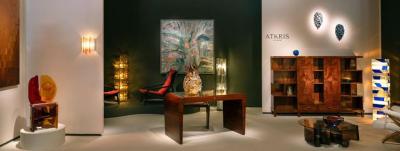Wizards of Wood How Makers are Reinvigorating Contemporary Furniture Design with Wood
 |
How Makers are Reinvigorating
Contemporary Furniture Design with Wood
by Benjamin Genocchio
Wood is back in fashion in design, though it never really went out of favor except for a brief period in the middle decades of the 20th century when industrial materials such as glass, various metals, and a range of new plastic products came onto the market and dominated interior design. Today a renewed focus on natural materials as part of a cultural push toward sustainability in design has led a new generation of makers to blend wood and wood products with the versatility, durability, and malleability of industrial materials to create some new, astonishingly original contemporary furniture that is both comfortable and stylish.
Incollect is dedicated to finding, supporting, and celebrating the creativity of contemporary makers of furniture from around the world. Process is an important part of the production of contemporary furniture in wood and with that in mind, we have tried to focus on makers that use, employ, or simply support craftsmen and techniques that are somewhat unusual or original in today’s crowded mass-produced design market. The results are nothing short of spectacular.
 |
 |
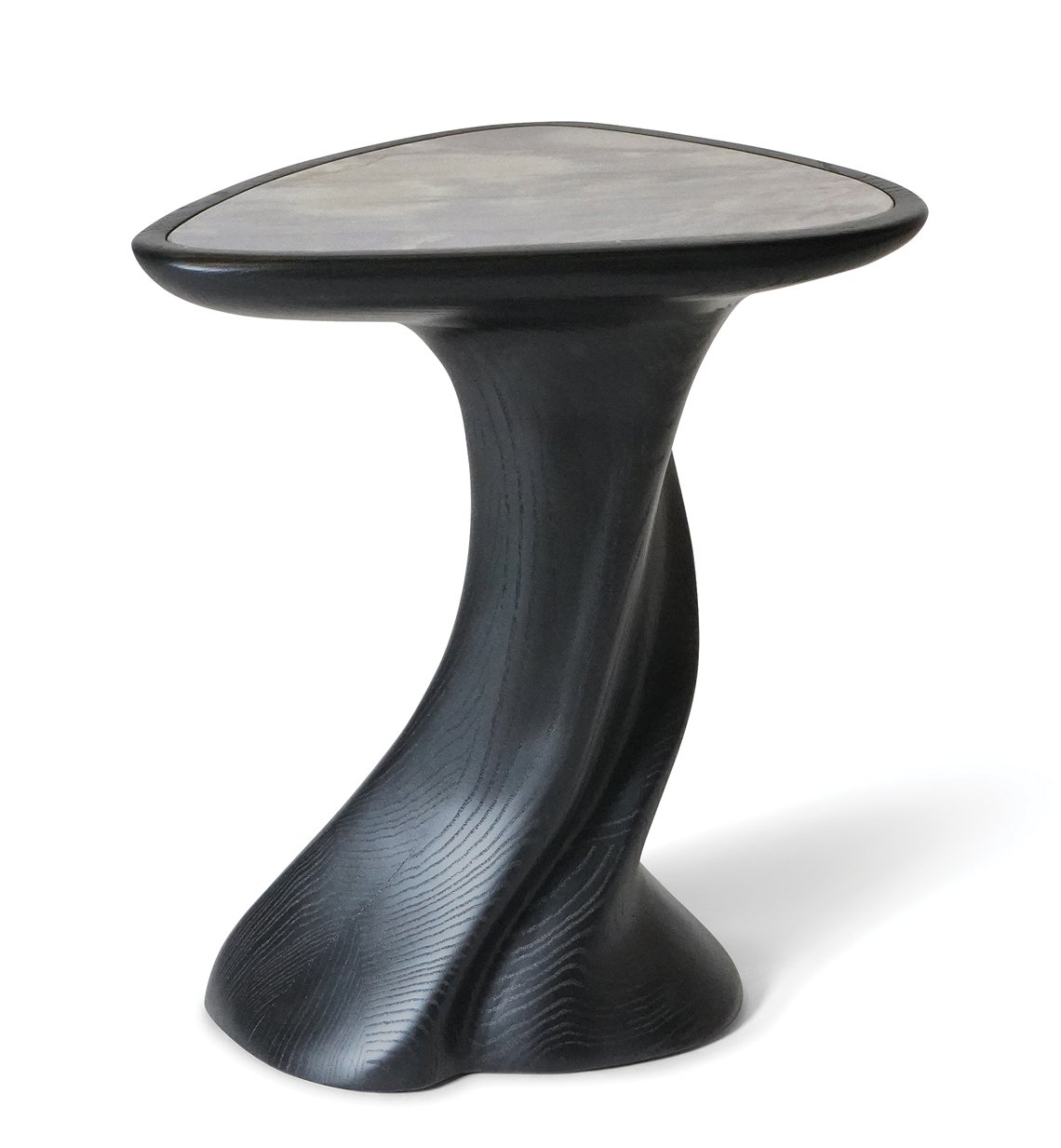 |  | |
| Left: The Abbi Side Table in ebony-stained ash with a marble inset top. Right: An entrance foyer with the Petra Console Table, a timeless form that appears both naturalistic and futuristic. | ||
“We use wood as our main material because each wood species has unique patterns and grains. The direction of the wood grains adds an extra element to our designs. It is something that I, as a designer, cannot control and it always surprises me,” says Amir Habibabadi, owner of Amorph, a design/build studio in Los Angeles. “Additionally, each type of wood has its unique strength, softness, or hardness, which can be challenging,” he says.
His most popular design is an entrance door. “The concept behind it was to combine the door handle with the door panel, creating a sense of unity and a special rhythm,” he says. The handle seamlessly emerges from the door. “We prefer wood over other materials because it is a live and challenging material. It has a grain that adds texture to all our pieces. Additionally, wood is a natural material that humans have used for thousands of years. We believe that wood can be integrated into modernism and help us define a contemporary and futuristic style using organic materials.”
 |
| Left: Inspired by Zaha Hadid’s fluid structures, Amorph’s Amir Habibabadi’s design for the Frolic Wall Mount Console exemplifies pure organic form. Right: The Nyx Coffee Table in ebony cerused stain, which highlights the wood grain and the sculptural curves of the design. |
Habibabadi’s design inspiration comes from the movement of soft material in space. “I capture that moment and influence it through my design methodologies. I focus on capturing form and geometry while also embracing function to make it usable. Another design approach I take is challenging the form through structure. I create a structure that transfers the load to the ground using diagonal or bracing elements.” He is currently incorporating stone as another material in his designs. “The goal is to combine wood and stone to create a soft, curved form using both materials.”
 |
 |
The Eileen Writing Desk is a svelte, clean-lined design with elegant French art deco style, shown here in sandblasted American white oak with an inset top of Breccia Capraia marble. |
“The timeless beauty of wood is what comes to mind when I think of why it’s fashionable in furniture today,” says Joseph Cleghorn, who, along with partner Connor Moxam, helms the Brooklyn-based design-build practice Chapter & Verse. “We consider ourselves studio furniture makers, using mixed materials as required by each project, with wood as a foundation element,” he says. It is also the foundation of their practice as furniture makers. “I think knowing how to work wood is a requisite for making and if you know how to work with wood, then I have found all the other materials skills sort of fall into line.”
 | |
Fine details distinguish the Bancroft Bedside Table. Fluted tambour drawer fronts, rounded corners, and a gracefully curved base are brought together for this sophisticated design in French walnut and satin lacquer with a marble top. |
Cleghorn is living his childhood dream, he says. He made his first piece of furniture in elementary school and went on to complete a studio furniture apprenticeship where he learned to work with wood. Together with Connor, who studied visual arts and engineering, they create some of the most stylish and innovative custom-made furniture on the market today. Everything is handmade at their 7,500-foot studio in the Brooklyn Navy Yard, where they employ a team of 10 people.
They work almost exclusively on commission and complete nearly 100 bespoke pieces a year. The Northeast is where a majority of their wood is sourced via local distributors, specifically white oak (increasingly the material of choice for custom interiors), as well as walnut, maple, some teak, and exotic veneers on occasion like ebony and lacewood. “We are known for our finishes,” Cleghorn says. “The other thing that distinguishes us as makers is that we only go one speed, everything is archival, every piece is as well built and finished as it can be — that is one of our core principles, making things that last.”
The makers often get requests from designers and architects to create designs that resolve unique, often complicated interior challenges and needs. “We are solution-oriented, system thinkers. My partner Connor and I often joke we take all the projects that are too hard or no one else wants. Everything we do is technically difficult. These kinds of clients know what they want, they want it perfectly executed, and want it to look effortless and new.”
 |
,-2022.jpg) |
Untitled (bench) 2021. Douglas fir, linseed. Originally made as a 13’ long version for a project in New Orleans, this can be made to order in custom sizes. |
,-2022_0.jpg) | |
Untitled (sketch 28) 2022. Douglas fir, linseed, at 95 inches tall, this standing form has presence as well as grace. A 42” diameter partial circle has been carved from the block. In what the artist refers to as an “incomplete form,” the circular void lends an air of mystery, hinting at another alternate dimension. |
Christopher Norman is a Los Angeles-based artist who creates formal objects for living. His large-scale wooden artworks begin first as gestural drawings, for spontaneity and human touch, and are critical to his design practice. “Having worked and made things with my hands my whole life, I like to forego computers in the design process and instead deploy pre-CNC industrial milling machines. With these devices, I can explore the connections between the body, plant-based materials, and early industrial tools.”
He also likes to let the material dictate the direction of a design. “Each sculptural element is a snapshot of the tree it came from,” he says, the artist crafting designs from single segments of wood derived from wild-foraged or fallen trees (rather than commercially treated timbers) weighing as much as 3,000 pounds. “Rather than building forms, as one might in architecture or additive manufacture, I find form in subtraction, cutting away matter to reveal a final shape which is discovered through the process.” The cast-off wood goes to urban farmers located throughout LA.
Research is very much at the core of his practice which often references fundamental and enduring forms that humans constantly return to. “In addition to being trained as an architect, I have been a visiting scholar at the American Academy in Rome, where I investigated ancient homes. I seek out commonalities in design history, domestic objects of antiquity as well as contemporary industrial and mass-produced elements, leveraging universal shapes to render objects at once surprising and familiar.”
 |
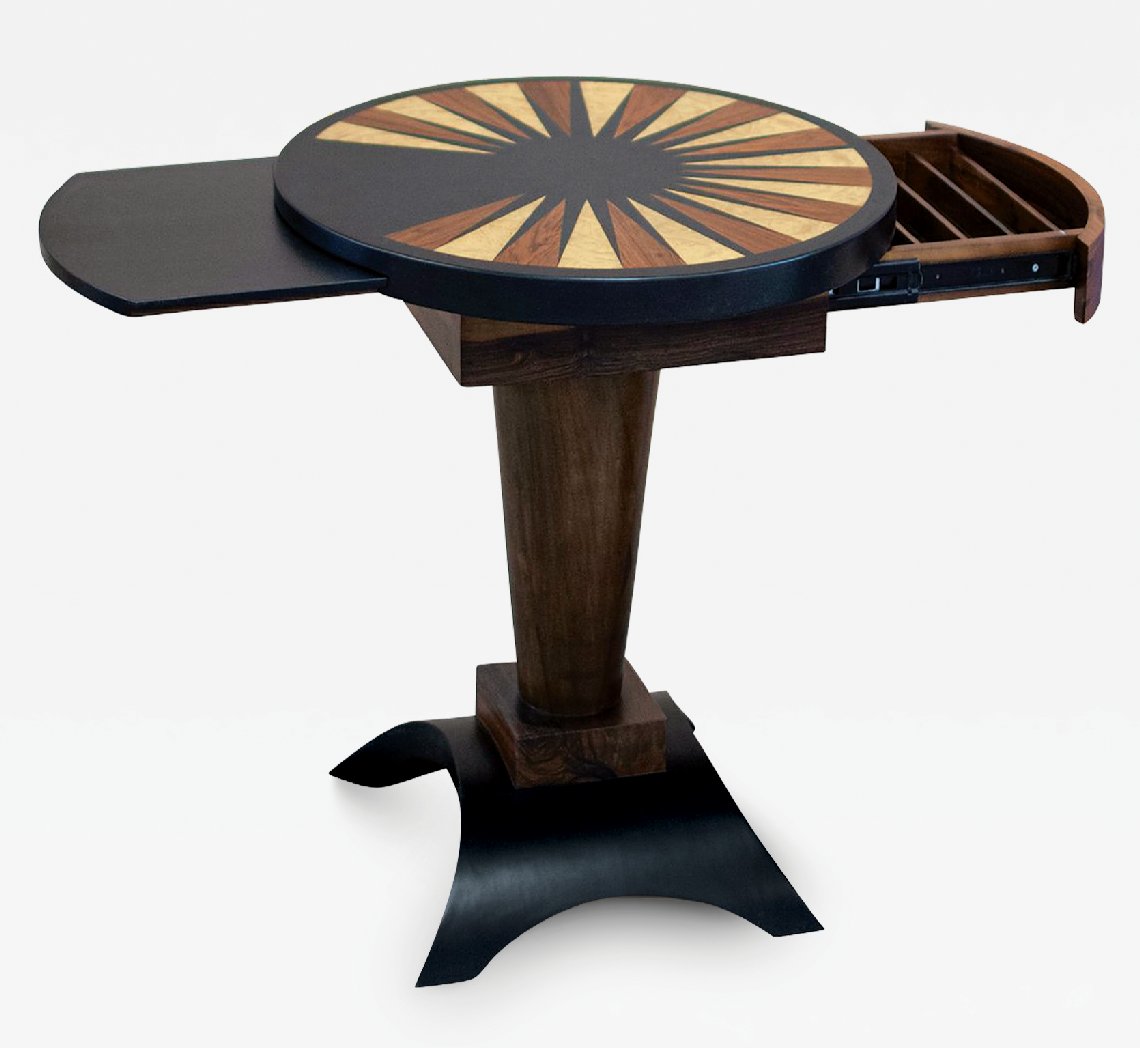 |  | |
Left: Intricate inlay work characterizes the Cherico Cocktail Table, which doubles as a backgammon table and was commissioned for the men’s lounge at the landmark New York City luxury retailer Bergdorf Goodman. Right: Each piece in the limited series Francisco Collection of hand-carved trunk tables is unique, with a live edge top tapering in an elegant curve. A selection of them was chosen for display in Louis Vuitton stores. | ||
 |
“Wood was the cornerstone of our collection when we first started making furniture in 2002 and it plays an important role in our design work to this day,” says the New York-based artist and designer William Stuart, who founded Costantini Design in 2002. Argentine rosewood, in particular, is his favorite material. “The Argentine rosewood finish that comprises a large percentage of our work is mesmerizing. Suitable for indoors or out, it ages gracefully and the objects we make are designed to be passed on for generations.”
Nearly everything in the line is produced by skilled artisans in Argentina. One of their most popular pieces is the Andre Table, a simple rectilinear twin pedestal form that shows off the natural wood material. The table is customizable in shape and size as well as the wood species depending on client preferences or a desired finish. It is also designed to age. “Outside, the dark grain will turn a silvery blond with age. Unfinished, it will darken from contact with the oils from our hands, and with use,” says Stuart.
 |
Natural wood, its beauty and grain, is also highlighted in the Francisco series of tables which he has produced in different materials. “We made a series of about 50 pieces, sustainably sourcing logs from northern Argentina. No two are alike and each piece is carved based loosely on the grain of the piece when we receive it at the workshop. They are then sanded and finished naturally to show off the natural beauty of the wood. Each one is hand numbered. They’ve been installed in Louis Vuitton stores and a Saint Laurent pop-up store in East Hampton. We are also working on a custom piece in the same material for a private client in the Caribbean.”
Costantini also uses veneers to do intricate inlay work, as on the Cherchio Cocktail Tables for the men’s lounge at Bergdorf Goodman. “We used sycamore, ebony, and Argentine rosewood to make round backgammon tables that double as cocktail tables for that project,” Stuart said. And the inspiration for the design? “We looked to ancient objects from Mesopotamia where the game originated to design the bases. That reminds me of one of my favorite facts about wood: how wood pegs were used by the Egyptians to split rock by wetting them so they would expand. Some of our newest pieces, like the Fortezza, are informed by this brilliant technique.”
 |
 |
The Townsend Coffee Table is built to order with a hand-sculpted base, and mortise and tenon joinery. The elliptical top has a beveled edge, shown here in ash with a custom blue grain filler and white bleaching stain with a walnut base. An all-walnut version is available, along with many other choices of woods and finishes. |
“My designs draw partly from the playful forms and colors of mid-century designs and also from elements of boats and architecture,” says Eben Blaney. As a child, he was surrounded by the materials, shapes, and overall composition of wooden boats constructed by his father in his coastal Maine boat shop. He liked to watch his father as he shaped, bent, and joined oak and cedar into boat hulls, an experience that provided early inspiration for woodworking. It also provided him with a memory bank of images and ideas that, he says, “fed my mind with sculptural forms.”
.jpeg-Costantini_.jpg) | |
Spare, elegant, and useful are the criteria that guide Maine-based furniture artist Eben Blaney’s work, but don’t be misled — the furniture has a rich and glowing lusciousness that is palpable. His hand-sculpted, custom-made-to-order Crane Console is one of his most requested designs. Other editions, including a version in poplar with a yellow lacquer finish, are available, the edition shown here is in South American mahogany with an ebonized finish that allows many of the rich reds and browns of the wood to show through, along with the distinctive grain. |
Blaney likes to construct and shape his furniture designs from wood using a combination of machine and hand tools. The wood itself, the natural qualities of each piece, and how they fit together also help shape many of the details that he includes in his final designs, he says. “Whether it’s an exposed tenon, a pegged joint or a strategically placed reveal I enjoy selectively incorporating certain traditional fine woodworking elements into new, often non-traditional forms thereby embracing the structural properties of solid wood while creating visual interest and distinctive handmade details,” he says. This quality is, in many ways, his signature.
Even with his more minimal and sleek designs that don’t feature visible features of joinery, the warmth and character of the variety of woods he uses help play a defining role in making each piece unique, he says. “A significant part of what I do as both a designer and maker is in reading and selecting wood that, when cut and shaped, reveals grain that harmonizes with the lines of my designs. Also, color and texture emphasize or create contrast between certain parts of a piece, depending on the desired effect within the particular item, and within the room it will inhabit. In this way, wood and its selection provide an additional layer of expression for me and my designs. I love the challenge of working with a material that has endless variation.”
 |
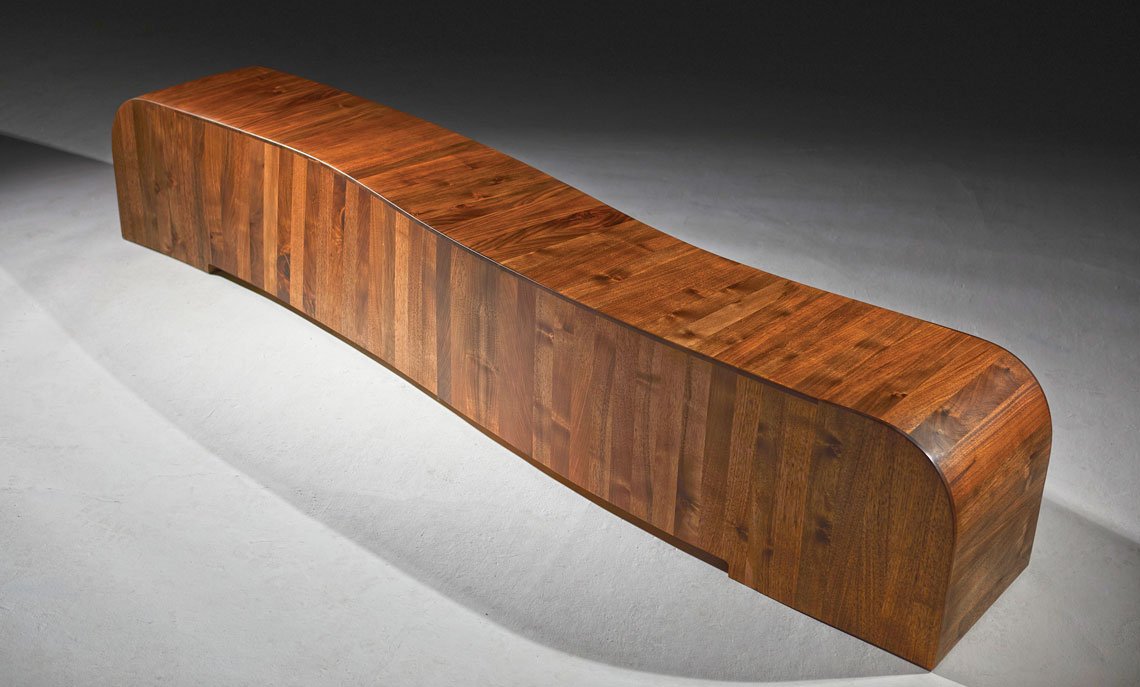 |
The Gallery Bench, designed to have a sculptural look and tactile feel, offers an alluring invitation to sit. A seemingly endless variety of wood tones and textures is reflected in the bands of American black walnut. |
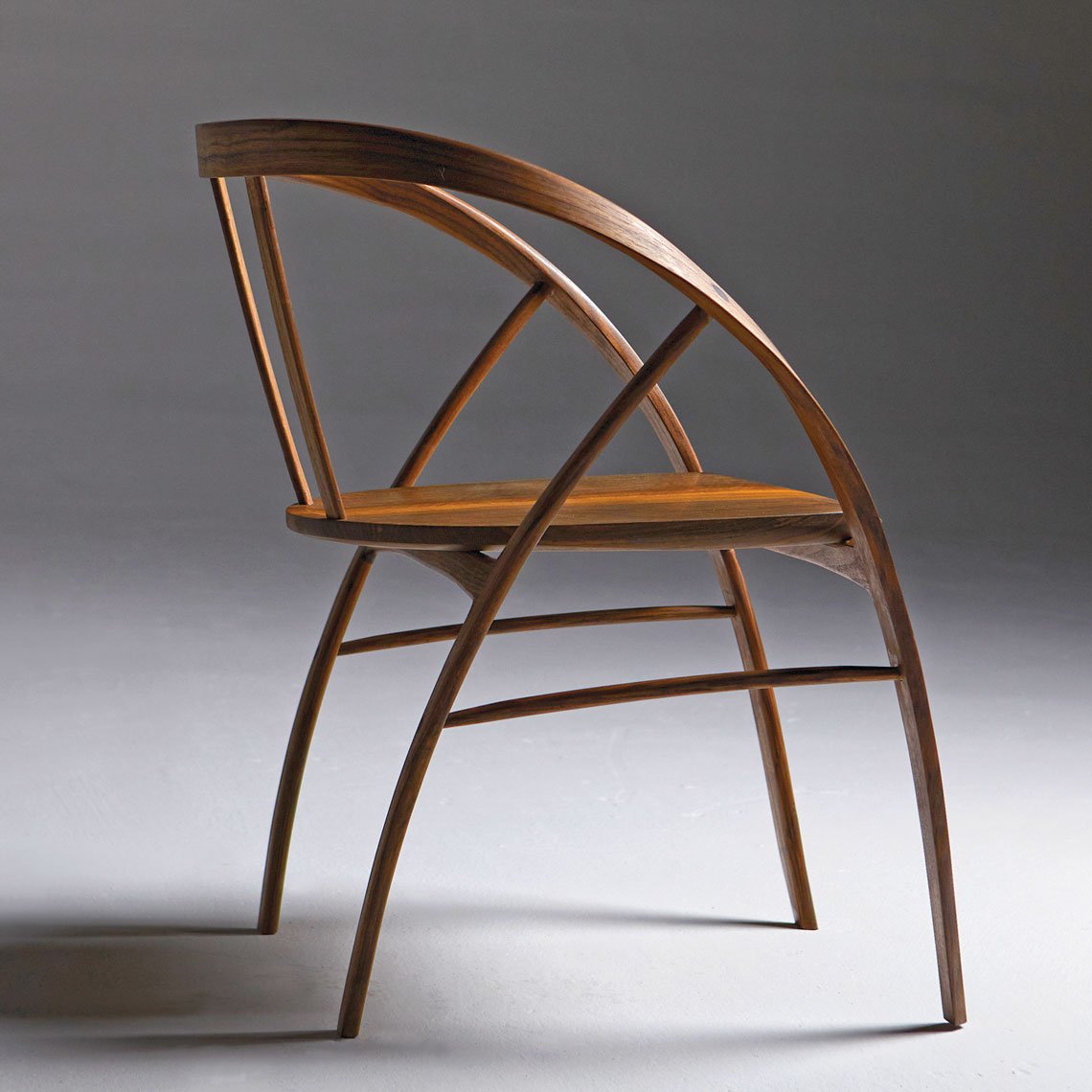 | |
Johnathan Field explained his design for the Carol Chair, “I wanted to create a chair with a lightweight frame that has a generous width and depth of seat.” With a frame in American black walnut and a seat in English walnut, a sleek and open form, and extremely comfortable, this chair checks all the boxes. The design is also offered in stool height and can be created in different timbers. |
“Wood has an incredibly enduring appeal for me, like a bountiful paint chart with never-ending variations in color and grain and beautiful imperfections that tell the story of the tree’s past,” says Jonathan Field who makes bespoke pieces of furniture from carefully selected timber. “Wood is such a flexible material that can be worked in so many ways: it can be carved, as in my Gallery Bench, or bent as in my Carol Chair, or just glued, as in table tops, and I can do all this in the smallest of studio workshops.” Field has just two people in his London studio, himself and Andy Gravelius, who joined him in 2013. “Together,” he says, “we have in-depth knowledge and a clear understanding of the processes with a profound respect for our craft.”
Field’s elegant, handmade furniture begins with his selection of timbers. “When sourcing timber for projects, I like to buy several consecutive slabs from the same tree, mostly UK-grown. When turning each slab over in the timber yard it’s like turning the pages of a not-yet-seen artwork.” His influences are many, but if he had to choose, he says, it would be the American midcentury designers and makers. “I aim to make pieces with a timeless feel that over time and with use, will be complemented with a patina of age.”
Field says his furniture is guided by an ethos, a philosophy of making for the present. “In my practice, I question the confines of the domestic and practical demands of furniture and interpret the human longing for a deeper connection to traditional crafts, contemporary aesthetics, and an engagement with natural materials,” he says. His work is shown at exhibitions and shows in the UK and abroad and by his gallery, Connaught Brown of London. Recent, signature pieces include a massive table in horse chestnut and a chest of drawers made of Scottish elm.
 |
 |
This dreamy custom chaise was commissioned by top interior design firm Fox Nahem Associates for Elle Decor’s Penthouse at 53 West 53 in Manhattan. Initially a unique one-off piece, it is now available to order. Photo: Kelly Marshall |
 | |
Ottra’s bestselling Asymmetric Bench is crafted with a hybrid process combining hand carving and CNC. Shown here with an upholstered shearling top, it can be configured as a table-height bench seat, or without the upholstered top as a coffee table or console table. In the background, a spectacular custom staircase designed and built by Ottra for their Brooklyn office/studio/workshop. |
Adam Zimmerman grew up in Texas, where tinkering around and working on home projects with his dad was his first introduction to creating with wood. “I loved the endless possibilities and the fact that it was a material I could work with, even as a kid with little skill,” he says. Zimmerman was later trained formally as an architect, so one of his first exposures to wood professionally was with several timber-framed buildings he designed. “Through this, I gained an appreciation for the various practical benefits, but also the softness it imparted on the building and the interior.”
“The unique and sometimes unexpected grain patterns and the varying degrees of color within a slab of wood ensure every piece we create at Ottra here is truly one of a kind,” he says. Much of their work is also unique because it is custom made. “This past year was exhilarating, as we completed a new staircase in a Miami home designed by Fox-Nahem. We are also working on another staircase for a home in San Diego. Both are similar to the one in our studio here in Brooklyn, but were designed specifically for the spaces.”
Sources of inspiration for Ottra furniture vary but the essence of the brand lies in 20th-century modern masters like Saarinen, Le Corbusier, and Noguchi. “As a practicing architect, it’s hard not to be influenced by the work of these past design masters, both in terms of their buildings as well as the furniture,” he says. “And I’ve always had an affinity for artists like Donald Judd and Constantin Brancusi. If you look closely, I think you can draw connections, even with Judd’s more playful works.”
 |
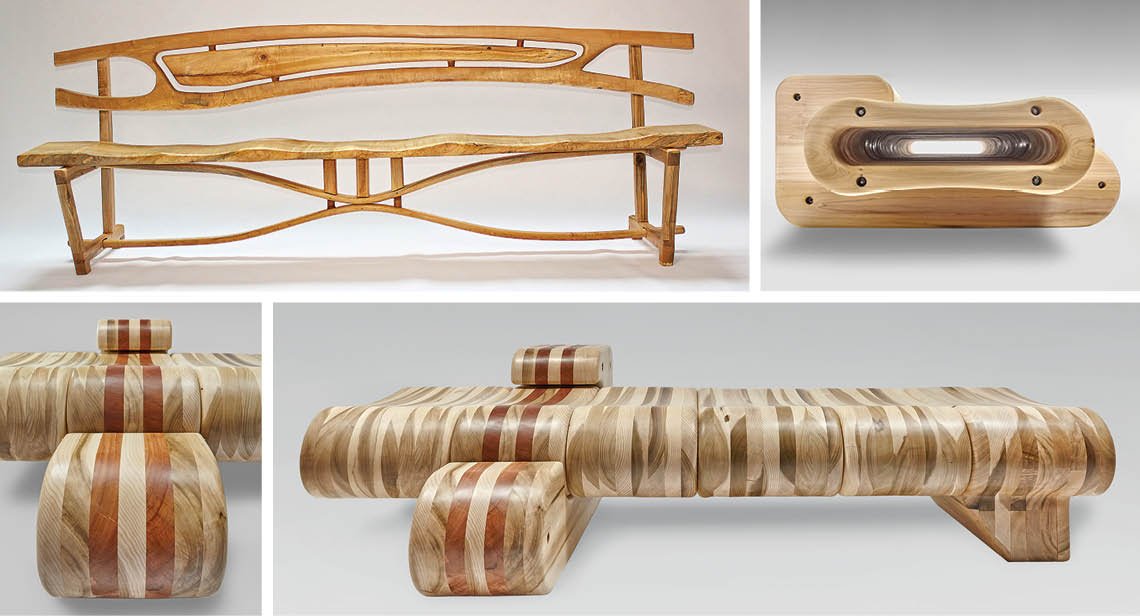 |
Master craftsman Martin Zelonky works utilizing both traditional and contemporary methods. Some pieces are crafted entirely by hand, and others utilize CNC software, which allows customization of complicated designs. Clockwise from upper left: The hand-carved Whimsy Bench in spalted maple; side view of The Whitney showing the hollow core; the laminated Whitney, built using CNC software, was designed for large spaces such as entrance foyers, lobbies, or showrooms and has no front or back side, allowing limitless flexibility in placement. |
“I came to love wood early having crawled around in the sawdust of my great grandfather's workshop, absorbing the texture and smell of pine shavings,” says Martin Zelonky, today a master craftsman and furniture maker.
 |
“When I was twenty I studied fine cabinet making and modeling for two years at the University of Wisconsin. Upon graduation, I then taught vocational cabinet making in Chicago.” Zelonky was all set for a stellar career — family background, formal training, practical work experience, but his woodworking journey was interrupted for nearly 40 years while he pursued other interests. “I’ve spent the past 6 years, pretty much full time getting back into it,” he says, “and accepting and producing commissions from designers, architects and individuals. I work out of my studio in Connecticut where a variety of local woods are plentiful, including maple, walnut, sycamore and birch.”
“I work alone,” he says. “I try to let the wood speak, I try to listen. Some days in the studio are better than others. I’ll determine a curve, an arch, or a particular joint and then figure out if I have the skill set capable of building it. If not, I’ll modify it. I’ll determine the tool or tools that I am most familiar with and that will enable me to cut, shape, and assemble it. I’ll spend hours finishing the piece, enabling the spalting, the grain, or the burl to become a feature.”
One of his most famous and sought-after pieces today is the Whitney Bench. “The piece, which introduces my collection listed on Incollect.com, is one of my larger yet practical and most admired installations to date,” he says. The Whitney Bench sits in the lobby of a corporate office in Austin, Texas, as a part of a central seating area. “The fact that it is produced in part using AI software gives it a certain edginess” he explains. It also — on a more practical, commercial level — enables the shape and size to be modified to accommodate a client’s needs.
 |
.jpg) |
With a base design Inspired by the majestic trunks and sculptural roots of the Samaúma tree in the Amazon rainforest, the Suma Dining Table pays homage to a beloved and increasingly fragile natural habitat. The firm manages all its work with an eye toward sustainability, and it has been awarded an FSC (Forest Stewardship Council) certification. |
“Wood is very much back in fashion for furniture and interiors,” says Rodrigo Seger, the Vice President of Brazilian-based Herval Corporation, which owns and produces a high-end brand of handmade wooden furniture under the Uultis brand.
_9816c_0.jpg) | |
The Fane Armchair was designed to be visually appealing from all angles with a striking wrap-around spindle back into which a plush cushion nestles, creating, in effect, an armless armchair. |
Everything in the Uultis catalog is made of Brazilian woods such as walnut and teak sourced from sustainably grown renewable forests owned and operated by Herval. “I particularly appreciate the teak wood because of the variety in the grain pattern, making every piece unique. Even when we apply colors, we aim to maintain the natural appearance and it must look like wood,” Seger says.
Wood exudes elegance, warmth, and durability, according to Seger and for that reason is a popular choice for interior design schemes. It also is incredibly versatile, and “offers the possibility of making furniture in shapes limited solely by a creator’s imagination,” he says. Uultis works with several contemporary designers including Sergio Batista, a household name in the Brazilian design industry who has won several awards. Everything is manufactured in Herval’s production facility in Brazil. “Our plant has state-of-the-art machinery, yet nothing replaces the expertise of skilled carpenters working in our company, some with decades of experience making furniture for us.”
Though wood is at the core of everything Uultis makes, and what sets their brand apart from other products out there in the market, according to Seger, is their distinct design approach, which he describes as “stylish and minimal, yet complicated in ways — a reflection of Brazil’s finest natural materials and design sensibility,” And how about the level of comfort? “Our shapes draw inspiration from nature’s organic forms, and when combined with wood, they cultivate an exceptionally cozy ambiance.”























